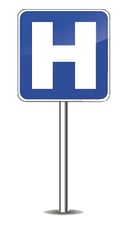Despite record low unemployment, you finally hired one – a diamond in the ruff. After a 16 hour shift on-the-road, his only question at the end of the day was, “What’s next?”
Things are going so smoothly, but then a call from your insurance agent, “The insurance company is hammering me. That new driver you hired has a DUI. They’re asking you to put him in a non-driving capacity or they're going to reevaluate your insurance program.”
As an insurance agent with many accounts in Construction, I’ve had numerous bad driver scenarios like this. It’s a trend getting hit from two sides with good drivers hard to find in low unemployment labor pool and increasing auto rates from insurance carriers driving up costs. Thankfully, for commercial insureds, there are solutions to the problem – prevention and alternative insurance options.
Prevent the situation with a Fleet Safety Program. A doctor might tell you prevention is the best medicine and it goes the same with avoiding the hire of a driver with a bad record. Implementing a well thought out Fleet Safety Program will set the standard for your company and, more often than not, keep this problem at bay.
Screening company drivers is the first step to setting up a Fleet Safety Program. “Frequency breeds severity,” is a saying in the insurance industry. If a driver has a history of minor violations or near misses odds are, at some point, a major incident will occur.
The best tool at the disposal of a business owner to screen employees is a Motor Vehicle Record (MVR). MVR’s are obtained through the Public Abstract Request System (PARS) program with the Wisconsin DOT. Your company can create an account here and begin screening drivers once they sign a release. There is a cost associated with running records, but nothing overly expensive.
Insurance carriers will want to be sure your drivers fall within a tolerable range of driving violations and accidents. Each company’s standards will be unique to them, but the above chart is an example of a standard the insurance carrier will expect a company to have. It's recommended you run MVR's on employees once a year, but if you join the PARS program it will notify you if a driver has a violation preventing the need to run MVR's arbitrarily every year.
A second step in implementing a Fleet Safety Program is to give safe driver training. There are a variety of ways to train drivers but the best training topic to explore is distracted driving because it's the number one reason insurance carriers are increasing auto rates. Another topic very useful for commercial drivers is Accident Investigation training. In the case of the companies I insure, we'll bring in experts to help train your drivers at no cost.
Explore alternative insurance options if the employee is too valuable to let go. There will be a cost to your bottom line but in many situations it is preferable to eat the cost rather than let valuable employees go.
Opening a separate insurance policy for a driver is an option. There are some circumstances where insurance carriers will outright refuse to insure certain drivers. In these cases an insurance agent can go to market with a carrier such as Progressive for a one-off driver policy. Costly - but often the only acceptable option.
Some situations can be fixed by changing work arrangements around. One solution to keep an employee with a bad driving record is to change their role by partnering them up with an employee who is able to drive. In some situations your company will be able to have the employee drive his or her own vehicle. While not usually the ideal solutions for your company, it will often appease insurance carriers and keep your coverage in place.
Companies going through these situations often entertain thoughts that insurance carriers are being overly harsh or risk averse in threatening premium hikes or non-renewing their coverage. The truth is underwriters are facing a hardening market on auto rates. It might actually come as a shock to some businesses to know that your vehicles are the single largest exposure to your company and your insurance carrier.
Insurance carriers have been losing money on auto insurance for years. The reason is that workers’ compensation claims have state-mandated limits, while auto liability does not. Innocent people hit by commercial vehicles often bring legal action. The consequences of distracted driving combined with our increasingly litigious society is the main driver behind increasing rates.
Screening employees and having a formal Fleet Safety Program is the best way to avoid a 15% auto increase or non-renewal. That said, when a company is against the wall and needs to keep an employee on the solution is to explore opening an additional policy or change their working arrangement.
Additional fleet safety resources:
 You most likely heard the news story recently where a Wisconsin School District was breached and scammed out of $660,000. Yet another example of a local cyber breach making national news.
You most likely heard the news story recently where a Wisconsin School District was breached and scammed out of $660,000. Yet another example of a local cyber breach making national news.
 On June 24th, 2019, President Trump signed an executive order on hospital and insurer price transparency. The Centers for Medicare and Medicaid Services (CMS) will decide through rulemaking whether hospitals and insurers will need to publish individual rates or whether they can keep their pricing information more general and publish only aggregate rates. Administration officials did not confirm when the rulemaking will take place, saying only they will use “any and all regulatory vehicles” that can carry out its directives.
On June 24th, 2019, President Trump signed an executive order on hospital and insurer price transparency. The Centers for Medicare and Medicaid Services (CMS) will decide through rulemaking whether hospitals and insurers will need to publish individual rates or whether they can keep their pricing information more general and publish only aggregate rates. Administration officials did not confirm when the rulemaking will take place, saying only they will use “any and all regulatory vehicles” that can carry out its directives.  Combined with rising tuition costs, more people are attending college than ever before. Sixty-one percent of millennials have attended college compared to forty-six percent of baby boomers. The class of 2017 graduated with an average of $39,500 in student debt! In recent years, some employers have begun offering student loan repayment help.
Combined with rising tuition costs, more people are attending college than ever before. Sixty-one percent of millennials have attended college compared to forty-six percent of baby boomers. The class of 2017 graduated with an average of $39,500 in student debt! In recent years, some employers have begun offering student loan repayment help. 


 Have you thought about renting a boat on a hot summer day? Do you own a boat and want to make some extra money by renting it out? If the answer is “yes,” there are a few things you need to know first.
Have you thought about renting a boat on a hot summer day? Do you own a boat and want to make some extra money by renting it out? If the answer is “yes,” there are a few things you need to know first. don’t know how many of you like online reviews—I know I do. A huge benefit of the internet is having so many businesses available to research and review with just the click of a mouse. Everything from contractors and restaurants, to vacation destinations and new cars. You name it…you can find it. Years ago, the only thing you could rely on was word of mouth or a good referral from a friend or relative.
don’t know how many of you like online reviews—I know I do. A huge benefit of the internet is having so many businesses available to research and review with just the click of a mouse. Everything from contractors and restaurants, to vacation destinations and new cars. You name it…you can find it. Years ago, the only thing you could rely on was word of mouth or a good referral from a friend or relative.  Governor Evers has signed an Executive Order 20 to create the Joint Task Force on Worker Misclassification.
Governor Evers has signed an Executive Order 20 to create the Joint Task Force on Worker Misclassification.  Alzheimer’s & Brain Awareness Month | June
Alzheimer’s & Brain Awareness Month | June With the employee shortage many companies are facing, attracting and retaining talent is critical. An untapped resource for many industries is younger talent – such as high school students. While minors can be a very valuable resource for employers, there are best practices to keep in mind so your organization continues operating safely and efficiently.
With the employee shortage many companies are facing, attracting and retaining talent is critical. An untapped resource for many industries is younger talent – such as high school students. While minors can be a very valuable resource for employers, there are best practices to keep in mind so your organization continues operating safely and efficiently.